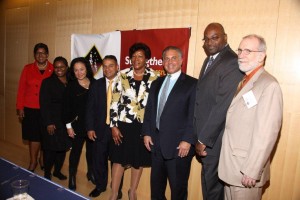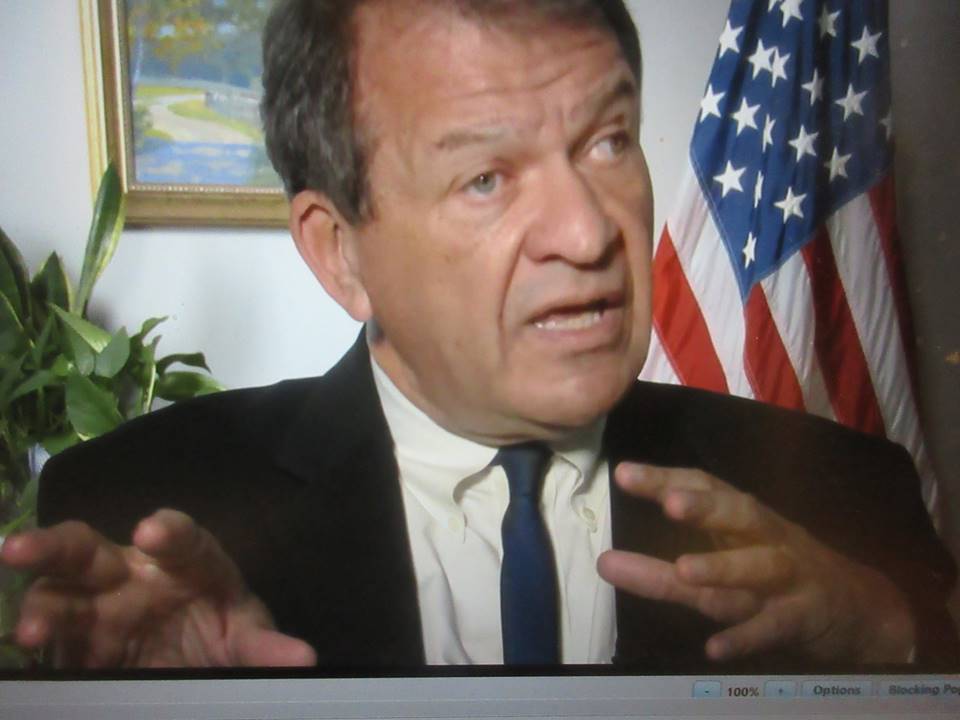Hits: 85

Panel Discusses Need for More Teachers of Color to deal with expanding minority population in the schools. Left to Right: Dr. Belinda Miles, President, Westchester Community College; Monique Toussaint, Senior Advisor, White House Initiative on Educational Excellence for African-Americans; Angel Pineiro, Jr., Senior Vice President of Services, ASI Systems Integration, Inc., Dr. Bettye Perkins, founder, President and CEO of Today’s Students Tomorrow’s Teachers; Lawrence Cohen, Partner and Head of Operations and Technology, Alliance Bernstein; Sterling Roberson, Vice President, Career and Technical Education, United Federation of Teachers, who served as forum master of ceremonies and Dr. Leo Casey, Executive Director, Albert Shanker Institute, who served as forum moderator.
WPCNR SCHOOL DAYS. From Today’s Students Tomorrow’s Teachers. October 29, 2016:
A panel of prominent educators, business, government and community leaders recently convened at Today’s Students Tomorrow’s Teachers’ first-of-its-kind Workforce Diversity Leadership Forum to address the skills gap crisis that is threatening America’s competitiveness in global markets.
The latest initiative by TSTT, held at Westchester Community College (SUNY) in Valhalla, NY, was the first in a planned series of high-profile forums by the non-profit aimed at calling attention to the urgent need for educating and training a diverse workforce.
The renowned panelists included Randi Weingarten, President of the American Federation of Teachers (AFT); Dr. Betty Rosa, Chancellor, New York State Board of Regents, Monique S. Toussaint, Senior Advisor, White House Initiative on Educational Excellence for African Americans; Larry Cohen, Partner and Head of Operations and Technology for Alliance Bernstein; Dr. Belinda Miles, President, Westchester Community College and Angel Piñeiro, Jr., Senior Vice President of Services, ASI Systems Integration, Inc. Dr. Leo Casey, Executive Director of Albert Shanker Institute, the think tank of the AFT, served as moderator.
Noted educator Dr. Bettye H. Perkins, founder, President and Chief Executive Officer of TSTT which has been at the forefront in helping to close the teacher diversity gap in America’s schools for more than 22 years, said that the “critical issue of economic growth and prosperity in our nation is directly linked to the urgent need to provide the ranks of our increasingly diverse workforce with the skills they need to compete in today’s ever expanding diverse global market.”
She added: “Until the diversity gap closes significantly in America’s classrooms, vast numbers of students will continue to enter the workplace lacking the essential skills to get the job done. Thus, the teacher diversity gap and workforce skills gap are two sides of the same coin that are eroding the country’s competitiveness in global markets. These forums are an urgent call to action to address this crisis.”
Dr. Betty Rosa echoed Dr. Perkins’ assessment that the problem starts in the classroom: “Students of color identify with teachers of color,” she said, “but one of the major challenges in the teaching profession is blaming teachers unfairly for society’s ills which has led to a teacher shortage, especially teachers of color.”
She continued: “There is also a problem with teacher retention due to low pay which does not reflect the after-school work teachers are obligated to perform.”
Ms. Toussaint said that the challenge was that “students in deprived neighborhoods are not getting the right resources or preparation for the work world.”
A key issue in the classroom is the glaring imbalance between teachers of color and an increasingly growing diverse student population, Dr. Casey observed. In fact, Dr. Perkins pointed out that only 13% of the teachers are teachers of color and less than 3% are male teachers of color. “But, just a few years ago we reached the tipping point where more than 50% of the students reflect the ever increasing diversity of our population,” she explained.
Messrs. Piñeiro and Cohen reflected on their technology background and what that means in the workplace. “Clearly, technology skills are in growing demand and teachers must be trained in technology and have more exposure in this real world need,” stated Mr. Piñeiro. Mr. Cohen added: “Students need high quality career and technical education and preparation for the real world and job market must start much earlier than college.”
The panelists recognized that TSTT’s accomplishment in closing the teacher diversity gap is not only making an important difference in the lives of youngsters who would otherwise face closed doors but also a positive difference in society.
As Ms. Weingarten explained: “We (the AFT) could have no better partner in this work in America than TSTT…Take the issue of diversity. We must be a country that embraces and celebrates our diversity, not fear it. That starts both at home and at school, which is why the rich diversity of our country needs to be reflected in who teaches our children. TSTT’s mission is so vital in this respect.”
The timing of the forum coincided with publication of Dr. Perkins latest article, Growing the Next Generation: A Program Encourages Students of Color to Become Teachers, featured in the fall issue of “American Educator,” AFT’s widely-read quarterly journal.
In it, Dr. Perkins relates her personal journey of growing up in the segregated South and how she started TSTT following a successful career as an IBM executive: ”In a country with an increasing population of nonwhite students, there are far too few teachers of color…black and Latino children sitting in classrooms with white teachers, day after day and year after year, can’t help but get the message: teaching and the educational attainment and authority it reflects, is not for people like them.”
The model that Dr. Perkins created has successfully recruited, mentored and trained about 150 culturally diverse and economically challenged talented high school students to become caring and committed teachers.
Currently, there are more than 150 TSTT alumni who are changing the lives of students in four states (New York, Connecticut, Massachusetts and Virginia) and a pipeline comprising more than 800 qualified high school and college students on their way of becoming committed teachers, school and community leaders.
Last year, Perkins and TSTT gained national prominence with two high-profile developments. The first was when the Albert Shanker Institute cited TSTT as one of eight programs as a solution to the teacher diversity crisis in its landmark report, “The State of Teacher Diversity in American Education.”
The second was Dr. Perkins’ participation as one of the distinguished panelists who addressed the 2015 Teaching & Learning Conference presented by the National Board for Professional Teaching Standards.
In closing comments, TSTT’s Workforce Diversity Leadership Forum panel said it was imperative to continue a collaborative team approach initiated with this discussion to assure success in addressing the diversity gap in both the classroom and in the skilled workforce. “We must combine the resources of educators, school administrators, businesses and government where some policies may have to change to meet the needs of an increasingly diverse student population,” Dr. Perkins told the panel.
Among the distinguished guests were New York State Senator Andrea Stewart-Cousins, Westchester Deputy County Executive Kevin Plunkett as well as representatives from TSTT partners in the business and non-profit communities , TSTT alumni teachers, administrators and students from Gorton High School, Yonkers, who are enrolled in TSTT’s mentoring program, among others.
